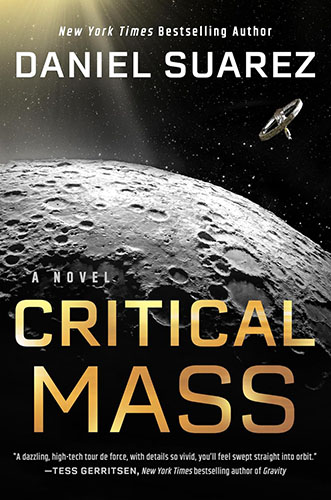Category: Fiction
Reviewed by: Susan Raizer
Title: Critical Mass
Author: Daniel Suarez
NSS Amazon link for this book
Format: Hardcover/Kindle
Pages: 464 pages
Publisher: Dutton
Date: January 2023
Retail Price: $28.00/$14.99
ISBN: 978-0593183632
Note: I reviewed an advance proof and some changes may have occurred before the book was published.
Critical Mass is the sequel to the author’s Delta-V (reviewed previously). This is the seventh book written by New York Times bestselling author, Daniel Suarez. It is a high-tech fiction novel about how a diverse group of people who only wanted to rescue friends stranded near an asteroid, become the impetus for innovation and hope for an Earth that is rapidly succumbing to the disasters of climate change. Not only do their efforts result in new technologies, but also in a new cadre of astropreneurs (Earth-based innovators who use space materials for the benefit of humans both on the planet and in space), who use the changes to also create a new global economic system tied to improving the deleterious effect of climate change, which is critical for the continuation of life on Earth.
The author, Daniel Suarez, was a former systems consultant to some of the major Fortune 1000 companies. Prior to the completion of the subject book, he authored Daemon, Freedom, Kill Decision, Influx and Change Agent. His books are science fiction suspense novels that center on high-tech innovations.
The book begins with the return to Earth of three of the eight Astro miners that readers met in Delta-V. Three died near the asteroid they were mining, and two remain on their ship, the Konstantin. The three who returned are met with awe by some, condemnation and vilification by others, and disbelief by many. The character John Tighe returns with two impacts on his life: he has cancer and he is mono-focused to find a way to rescue his two friends still in space. He is more desperate for the latter especially when their last communication reveals that the Konstantin has been taken over by the North Koreans and the fate of the miners is unknown. Added to this is the fact that the closest transit to the asteroid will again happen in four years. The return of the three has expanded global tensions, which threatens to thwart the plans for the rescue. Their only hope is to build their own spaceship.
Unbeknownst to many, the vilified billionaire who built the Konstantin and its ancillary equipment, also secretly built the shell of a spin-gravity space station and left plans to build a station on the Moon in order to mine the regolith on the Moon. By building out the space station with materials harvested at the asteroid and sent back to Earth, our protagonists could then build the first orbiting solar powered satellite and robots to mine the Moon and using in situ materials to build a mass driver to launch their spaceship. All the engineering is also accompanied by the establishment of a new crypto currency that is tied to reversing global warming.
John Tighe’s cancer is cured and supporters among the major space companies launch him and his colleagues to the space station along with professionals in various disciplines and two international observers. Over time, the station, named Clarke Station after one of the lost miners, is built, and more and more people come to live and work on the station. Many scientific, engineering and technological advances are made not just to further their agenda, but to improve life on Earth. By learning how to use the resources from the Moon and space, new technologies are also created to improve life on Earth. The transition to a space sourced reservoir of materials can help the effects of climate change be reversed.
Although there are more and more supporters for the space station and the Moon operations, there are still detractors especially when our protagonists realize that the only way to get to the asteroid in time is by using nuclear power (hence the name of the book). They do use a form of nuclear power and launch to the asteroid, only to find one of their friends and several North Koreans living in poor conditions.
The book contains illustrations of the space station, robotic tug and a satellite. The book also contains a bibliography for further study.
This reviewer recommends Critical Mass to National Space Society members for several reasons. First, the book is well-written and keeps the reader’s interest. Second, the book touches on the very sensitive topic of how climate change is impacting the Earth and its people. Third, for the engineering-inclined among our membership, the description of the state-of-the art technological equipment is both fascinating and challenging. Fourth, with all the private contractors currently operating in the space arena, the book provides the reader with an in-depth education in the legal, political and ethical realties that these companies now face if they want to continue working in space.
© 2023 Susan Raizer
Please use the NSS Amazon Link for all your book and other purchases. It helps NSS and does not cost you a cent! Bookmark this link for ALL your Amazon shopping!




















